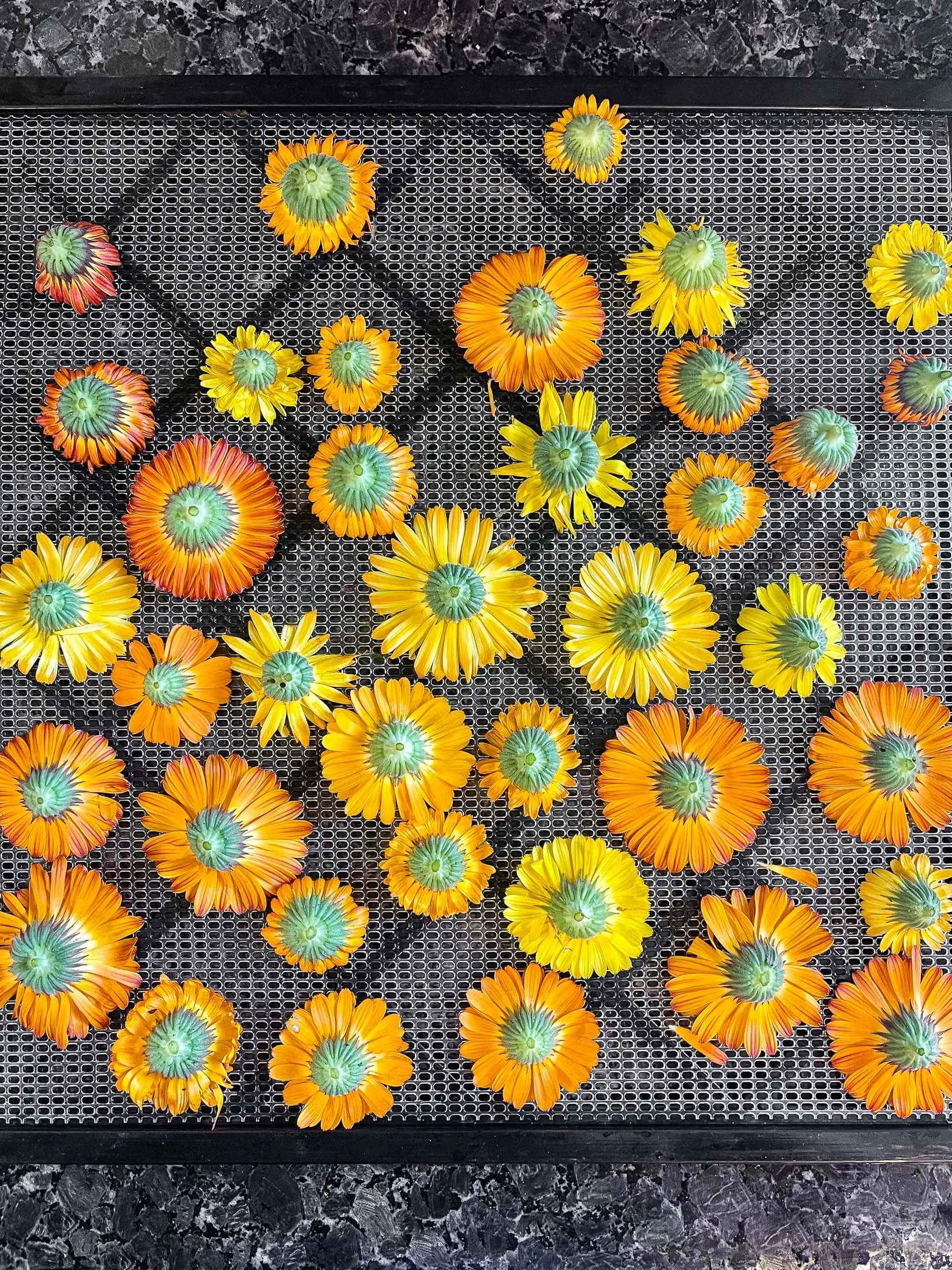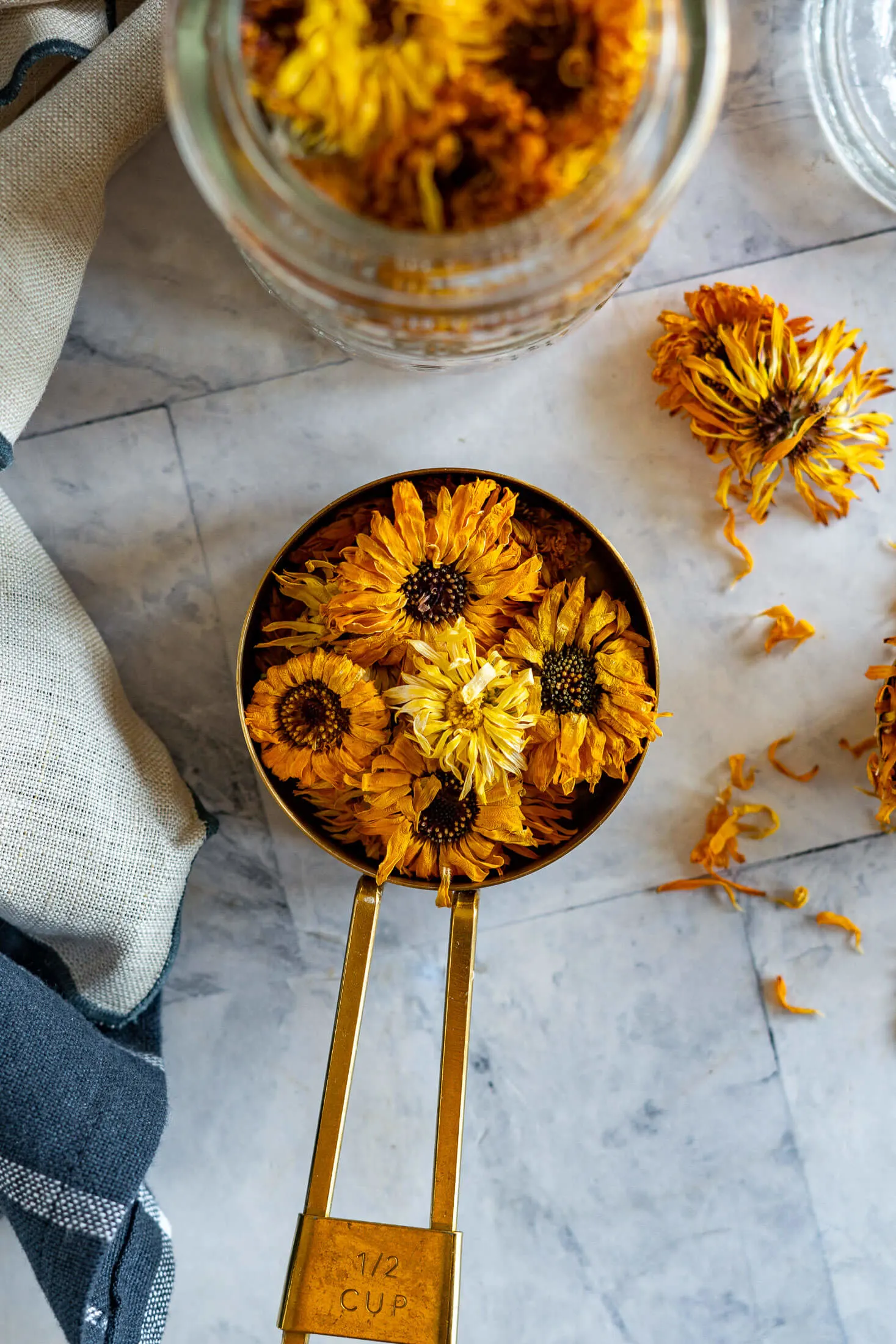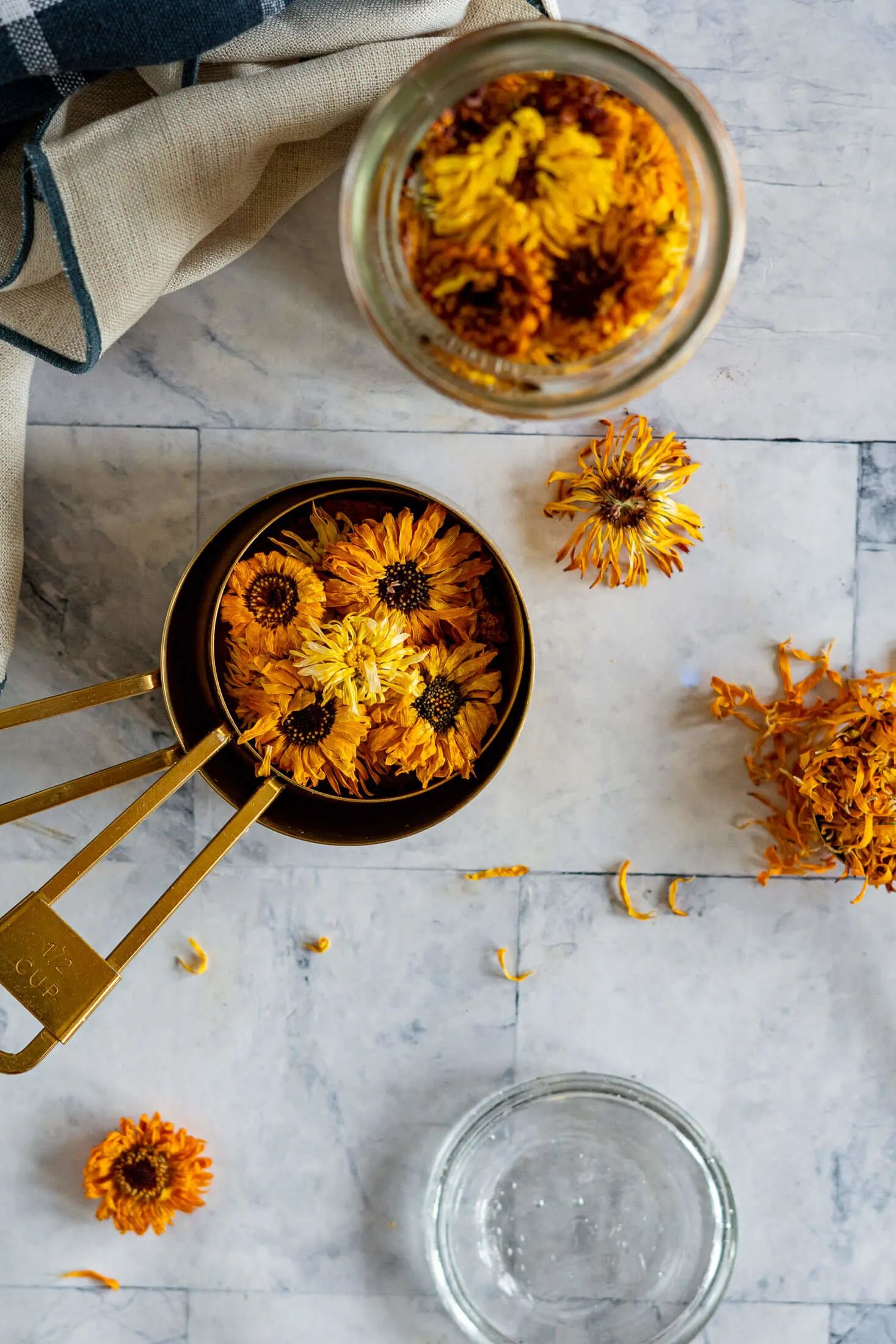Learn easy steps to harvest, dry, and store beneficial calendula flower blooms for year-round use in recipes, skincare products, and more.
Calendula officinalis, also known as pot marigold, is such a great flower to grow in your homestead garden or food forest. Though it shouldn't be confused with the actual marigolds, Tagetes spp.
Not only do calendula plants brighten up any garden with their vibrant orange and yellow blooms, but they're also grown for their beneficial properties.
Calendula is easy to grow, and highly productive, and its edible petals can be used in a variety of ways – from making soothing skin creams and balms to adding a splash of color to salads and dishes. Plus, it's a great plant for attracting beneficial insects to your garden. Truly a multi-purpose gem in the world of gardening!

As an Amazon Associate I earn from qualifying purchases.
Jump to:
How To Harvest Calendula Flowers
Harvesting calendula blossoms is super easy and actually completely necessary! Regular harvesting of flowers encourages the plant to continue to flower. Calendula is an annual and its life cycle consists of germinating, growing, producing fruit (seed), and then dying at the end of the season. So through continued harvesting, you'll encourage the plant to continue to bloom, and bloom more profusely.
Calendula flowers should be harvested on dry days, around mid morning, when the dampness from morning dew has evaporated to ensure the flowers are fully dry and free of moisture.
Choose flowers that are somewhere between halfway and completely open. The beneficial compounds are the highest in between those stages. Once the flower is completely opened, the outer petals quickly start to wilt and lose their magic!
Avoid harvesting the flowers well in advance of drying, as they do tend to wilt quickly. If you must harvest now for later use, make sure to cut a long stem with the flower and place the stems in a jar or container of cool water in a cool place until you can process them.
Snip or pinch flowers directly below the flower head where the crown meets the stem. This is often easier done with scissors or garden snips.
Avoid washing the flowers, especially if you're collecting flowers from a location you know to be herbicide and pesticide free. When I'm harvesting calendula from my own yard, I never need to wash because we grow chemical free in our garden and food forests. If required, you can give the flowers a quick shake to knock off any dust or bugs.

How To Dry Calendula Flowers
Once the harvesting is over, the easy part begins! I find it's easier to dry the flower heads whole and then use them as is or remove petals as required later on. Working with petals is difficult because they are basically weightless and so itty bitty!
With A Dehydrator:
- Place flowers face down in a single layer on a mesh dehydrator tray.
- Dehydrate at 90-95f for up to 24 hours.

Without A Dehydrator:
- Place flowers face down in a single layer on a drying rack, a wire mesh baking rack, or even thread them onto a long thread.
- Keep the flowers in a dry place with lots of airflow, preferably away from the sunlight which can cause color degradation.
- Dry flowers for 6-8 days.
How To Tell If Flowers Are Completely Dry
When you're drying calendula flowers, a lot of the process is the same as it is for other dried foods, but determining doneness is a little harder because these flowers have large heads which take much longer to dry than the petals.
You can tell your calendula flowers are dry by handling them. The petals should be brittle and separate from the head easily.
When in doubt, always give your flowers more time to dry as moisture can ruin the hard work and time put into your dried flowers.

Storage
Dried calendula flowers last a LONG time if properly stored and conditioned (more on that below).
Once completely dried, store dried calendula in mason jars or other containers with airtight lids to minimize degradation. Feel free to vacuum seal the jars shut, especially if you have multiple batches, that way only the current open jar is un-vac sealed.
Keep your jars or containers in a cool, dark place to prevent sunlight from blanching the bright, beautiful flowers.
Expect the dried flowers to last up to 12 months under proper conditions, and as long as the flowers maintain their vibrant color, they should be good to use.
Conditioning Calendula
Conditioning is an important step in the dehydrating process, and I'd argue, one of the most important steps. If it's skipped or done improperly, the entire batch can be ruined. It's a super easy process that requires almost no work at all, aside from observation.
Conditioning is basically the process of equalizing moisture in a dehydrated product. There is almost no way to have all of the pieces reach equal dehydration, some will inevitably have moisture remaining in them. Conditioning helps to account for that.
Once the flowers are dried, and packed away in their storage jars they should be placed somewhere that you'll see them every day or so for the next week. During this time, you'll gently shake the jar daily or so to shuffle around the dried flower heads and watch for signs of condensation on the jar.
If after a week of conditioning, you observe no signs of moisture in the jar, they are good to go for long term storage. If you do see signs of moisture, they must be returned to the dehydrator or drying rack to dry further before being packaged and re-conditioned.

Using Dried Calendula
The uses for your dry calendula are limitless and bound only by your imagination. Here are some great ways to use your dried calendula.
I'm going to make calendula soap with some of my dried petals!

Calendula Benefits
Every natural healing reference book I've purchased has a section on calendula which just goes to show how valuable a plant this is. While the flower lacks substantial official scientific study and evidence, its continued use in folk medicine withstands the test of time.
That said, calendula use is approved in Germany as an anti-inflammatory and as a wound-healing agent. When used topically, calendula can help improve skin's hydration. Calendula is on the GRAS (generally regarded as safe) list provided by the FDA. Studies are emerging that are proving what our ancestors have known for years, that calendula has anti-fungal and anti-microbial potential!

Notes From The Homestead Kitchen
Harvesting and drying calendula flowers is a wonderful way to preserve the amazing beneficial properties this herb has to offer. It may take some trial and error to perfect your process, but with practice, you will be able to harvest and dry calendula flowers for all sorts of uses! From teas to salves, lotions, soaps, and more, you'll be able to enjoy the benefits of your home-grown calendula year-round.
Drying Calendula Flowers

Unlock the full potential of calendula flowers and learn the simple steps to harvest, dry, and store them for year-round use. From making herbal remedies to enhancing your culinary creations, dried calendula flowers offer a world of possibilities.
Ingredients
- calendula flowers, freshly harvested
Instructions
With A Dehydrator:
- Place flowers face down in a single layer on a mesh dehydrator tray.
- Dehydrate at 90-95f for up to 24 hours.
Without A Dehydrator:
- Place flowers face down in a single layer on a drying rack, a wire mesh baking rack, or even thread them onto a long thread.
- Keep the flowers in a dry place with lots of airflow, preferably away from the sunlight which can cause color degradation.
- Dry flowers for 6-8 days.
Store Dried Flowers:
- Once completely dried, store dried calendula in mason jars or other containers with airtight lids to minimize degradation. Feel free to vacuum seal the jars shut, especially if you have multiple batches, that way only the current open jar is un-vac sealed.
- Keep your jars or containers in a cool, dark place to prevent sunlight from blanching the bright, beautiful flowers.
- Expect the dried flowers to last up to 12 months under proper conditions, and as long as the flowers maintain their vibrant color, they should be good to use.
Condition Dried Flowers:
- Once the flowers are dried, and packed away in their storage jars they should be placed somewhere that you'll see them every day or so for the next week. During this time, you'll gently shake the jar daily or so to shuffle around the dried flower heads and watch for signs of condensation on the jar.
- If after a week of conditioning you observe no signs of moisture in the jar, they are good to go for long term storage. If you do see signs of moisture, they must be returned to the dehydrator or drying rack to dry further before being packaged and re-conditioned.
Notes
How To Tell If Flowers Are Completely Dry
You can tell your calendula flowers are dry by handling them. The petals should be brittle and separate from the head easily.
When in doubt, always give your flowers more time to dry as moisture can ruin the hard work and time put into your dried flowers.
Storage
Once completely dried, store dried calendula in mason jars or other containers with airtight lids to minimize degradation. Feel free to vacuum seal the jars shut, especially if you have multiple batches, that way only the current open jar is un-vac sealed.
Keep your jars or containers in a cool, dark place to prevent sunlight from blanching the bright, beautiful flowers.
Expect the dried flowers to last up to 12 months under proper conditions, and as long as the flowers maintain their vibrant color, they should be good to use.
Recommended Products
As an Amazon Associate and member of other affiliate programs, I earn from qualifying purchases.
Pin This Guide To Drying Calendula Flowers!


